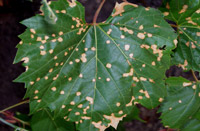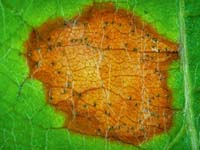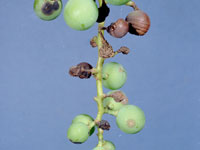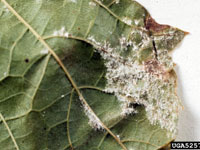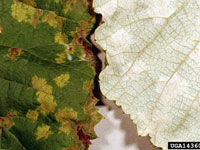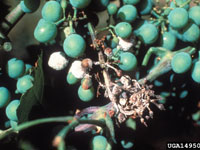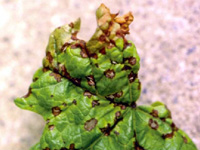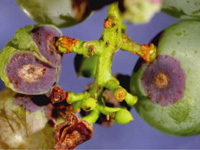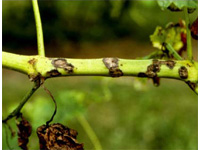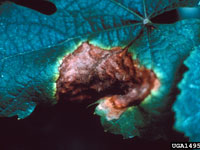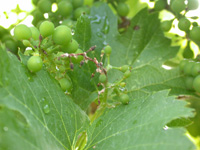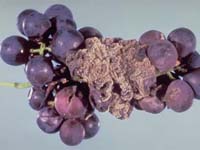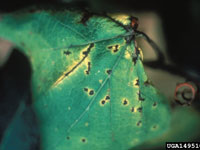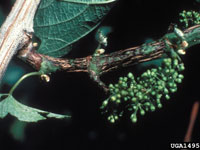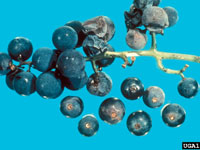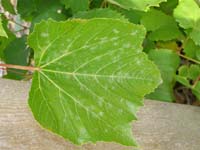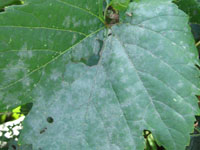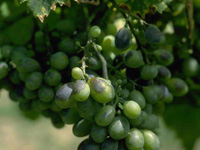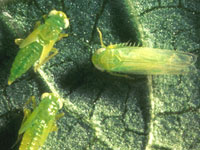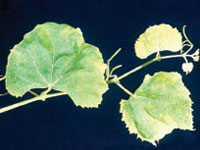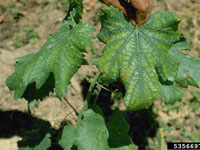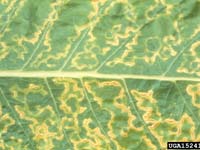Extension > Garden > Diagnose a problem > What's wrong with my plant? > Fruit > Grape > Spots/blotches/other discoloration
Grape > Leaves > Spots/blotches/other discoloration
1 of 9
Black Rot
Guignardia bidwellii
- Leaves have round tan spots with dark edges, tiny black pimples are often visible in the center of the spot
- Black slightly sunken ovals or short streaks can be seen on Infected young green vines, leaf and flower stalks
- A red ring appears on berries, this grows quickly until the entire berry is brown
- Berries that have been infected for several days dry up, shrink and wrinkle into a bluish black ‘mummy’ that remains attached to the cluster
- Multiple berries in a cluster can be infected
- Symptoms on berries commonly show up when the fruit is half grown
- More information on Black Rot
2 of 9
Downy Mildew
Plasmopara viticola
- Yellow-green “greasy” lesions develop on upper leaf surface
- Lower leaf surface develops a dense, white cottony growth under humid conditions
- Infected green fruit turn light brown to purple are soft, covered in a downy felt, and easily fall off the cluster
- Berries are most susceptible when pea-size (early summer) and again when approaching maturity (late summer, early fall)
- More information on downy mildew of grape
3 of 9
Anthracnose (Bird’s Eye Rot)
Elsinoe ampelina
- Leaves develop circular lesions with gray centers and brown or black margins, the center of the leaf spot may fall out resulting in small ragged holes in the leaf
- Infected shoots develop spots that become sunken lesions with gray centers and dark reddish-brown raised edges
- Infected shoots may be confused with hail damage; but unlike hail damage, the edges of the lesions are raised and black
- Berries develop small, reddish circular spots that average 1/4 inch in diameter that may become sunken with a dark brown to black margin, resembling a “bird’s eye”
- Berries are susceptible from bloom to veraison
- Infection is more prevalent in rainy years
- More information on Anthracnose (Bird’s Eye Rot)
4 of 9
Botrytis
Botrytis cinerea
- Leaves have large, red-brown patches; a gray mold may or may not be observed on the leaf
- Berries become soft and watery, and may be covered in a fuzzy white-gray mold
- White grapes will start to turn brown while purple grapes turn reddish in color
- Berries that have been infected for several days will shrivel and drop to the ground as hard mummies
- Multiple berries in a cluster can be infected
- More information on Botrytis
5 of 9
Phomopsis Cane and Leaf Spot
Phomopsis viticola
- Leaves may be puckered along the veins or the margins may be turned under
- Dark brown spots with yellow edges can also appear along leaf veins and petioles, the lower leaves are most commonly affected
- Fruit will turn light brown and shrivel, small raised black pimple like structures may be visible on the fruit surface
- Symptoms on berries are most obvious close to harvest on maturing fruit
- More information on Phomopsis Cane and Leaf Spot
6 of 9
Powdery Mildew
Uncinula necator
- Upper leaf surface develops white or grayish-white patches
- Berries may be misshapen, covered by the white, powdery growth and often split open
- Infected berries have a rusty spots; red varieties develop a blotchy appearance at harvest
- Can be more prevalent in drier conditions
- More information on Powdery Mildew
7 of 9
Leafhoppers
- Leaves develop pale yellow to white blotches, mostly near leaf margins
- Severe feeding may cause leaves to curl downward
- Leafhoppers are present from June through August
- Leafhoppers feed on the underside of leaves
- More information on Leafhoppers
8 of 9
Nutrient Deficiency
- Leaves are purple, red, light green, or yellow, depending on the nutrient that is deficient
- With magnesium or zinc deficiency, leaves turn yellow, but the veins remain green (interveinal chlorosis)
- Phosphorus deficiency turns the leaves red as the veins remain green
- Prevalent in soils with high or low pH (below 6 or above 7)
- More information on Nutrient deficiency
9 of 9
Tomato/Tobacco Ringspot Virus Decline
- Leaves exhibit a random pattern of yellows and greens or leaf yellowing in first year of infection
- Smaller leaves, shorter internodes, and reduced yield are evident in second year
- Growth is severely stunted in the third year
- Fruit clusters are sparse with uneven ripening
- More information on ringspot virus decline



